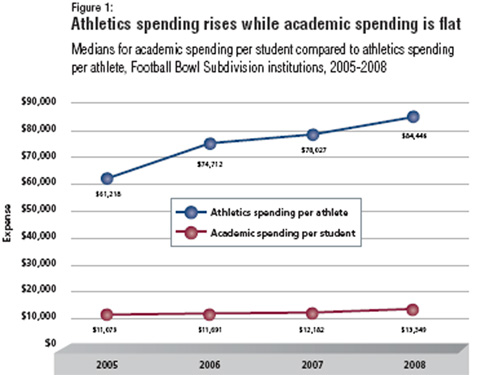The Knight Commission on Intercollegiate Athletics today released a report comparing university spending on athletes vs. those whose primary role at college is academics. Athletes won, the report says.
The Knight Commission on Intercollegiate Athletics today released a report comparing university spending on athletes vs. those whose primary role at college is academics. Athletes won, the report says.
In the Big 10, almost 7 times more money is spent on athletes than academics. That’s third behind the football-crazy SEC and the Big 12. And, the report says, spending on athletics is increasing while spending on academics is flat.

University athletics brings in revenue, but nowhere near enough to sustain itself, the report says. “Because sports revenues so often fall short of meeting the needs of athletics programs, almost all programs must rely on allocations from general university funds, fees imposed on the entire student body, and state appropriations to meet funding gaps,” the study said. “Indeed, reliance on institutional resources to underwrite athletics programs is reaching the point at which some institutions must choose between funding sections of freshman English and funding the football team.”
What’s the answer? The commission said all financial information about college athletics should be made public, figuring the reaction from the public will refocus athletics, just as it did when graduation rates of athletes were publicized.
The Commission also said the NCAA should not allow a college team to participate in post-season action if it doesn’t graduate at least 50 percent of its “student athletes.”
For the University of Minnesota, only 44% of men’s basketball players graduate. Fifty-four percent of the football team graduates.
But the total U of M graduation rate trails the student-athletes. Sixty-three percent of all students graduate, while 76 percent of the athletes do.
Here’s the full report.
